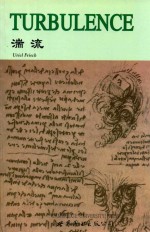

湍流PDF电子书下载
- 电子书积分:11 积分如何计算积分?
- 作 者:Uriel Frisch著
- 出 版 社:世界图书出版公司北京公司
- 出版年份:1998
- ISBN:7506238233
- 页数:296 页
CHAPTER 1 Introduction 1
1.1 Turbulence and symmetries 1
1.2 Outline of the book 11
CHAPTER 2 Symmetries and conservation laws 14
2.1 Periodic boundary conditions 14
2.2 Symmetries 17
2.3 Conservation laws 18
2.4 Energy budget scale-by-scale 21
CHAPTER 3 Why a probabilistic description of turbulence? 21
3.1 There is something predictable in a turbulent signal 27
3.2 A model for deterministic chaos 31
3.3 Dynamical systems 36
3.4 The Navier-Stokes equation as a dynamical system 37
CHAPTER 4 Probabilistic tools:a survey 40
4.1 Random variables 40
4.2 Random functions 45
4.3 Statistical symmetries 46
4.4 Ergodic results 49
4.5 The spectrum of stationary random functions 52
CHAPTER 5 Two experimental laws of fully developed turbulence 52
5.1 The two-thirds law 57
5.2 The energy dissipation law 67
CHAPTER 6 The Kolmogorov 1941 theory 72
6.1 Kolmogorov 1941 and symmetries 72
6.2 Kolmogorov's four-fifths law 76
6.2.1 The Kámán-Howarth-Monin relation for anisotropic turbulence 77
6.2.2 The energy flux for homogeneous turbulence 79
6.2.3 The energy flux for homogeneous isotropic turbulence 81
6.2.4 From the energy flux relation to the four-fifths law 84
6.2.5 Remarks on Kolmogorov's four-fifths law 86
6.3 Main results of the Kolmogorov 1941 theory 89
6.3.1 The Kolmogorov-Obukhov law and the structure func-tions 89
6.3.2 Effect of a finite viscosity:the dissipation range 91
6.4 Kolmogorov and Landau:the lack of universality 93
6.4.1 The original formulation of Landau's objection 93
6.4.2 A modern reformulation of Landau's objection 94
6.4.3 Kolmogorov and Landau reconciled? 97
6.5 Historical remarks on the Kolmogorov 1941 theory 98
CHAPTER 7 Phenomenology of turbulence in the sense of Kolmogorov 1941 100
7.1 Introduction 100
7.2 Basic tools of phenomenology 101
7.3 The Richardson cascade and the localness of interactions 103
7.4 Reynolds numbers and degrees of freedom 106
7.5 Microscopic and macroscopic degrees of freedom 109
7.6 The distribution of velocity gradients 111
7.7 The law of decay of the energy 112
7.8 Beyond phenomenology:finite-time blow-up of ideal flow 115
CHAPTER 8 Intermittency 120
8.1 Introduction 120
8.2 Self-similar and intermittent random functions 121
8.3 Experimental results on intermittency 127
8.4 Exact results on intermittency 133
8.5 Intermittency models based on the velocity 135
8.5.1 The β-model 135
8.5.2 The bifractal model 140
8.5.3 The multifractal model 143
8.5.4 A probabilistic reformulation of the multifractal model 146
8.5.5 The intermediate dissipation range and multifractal universality 149
8.5.6 The skewness and the flatness of velocity derivatives according to the multifractal model 155
8.6 Intermittency models based on the dissipation 159
8.6.1 Multifractal dissipation 159
8.6.2 Bridging multifractality based on the velocity and mul-tifractality based on the dissipation 163
8.6.3 Random cascade models 165
8.6.4 Large deviations and multifractality 168
8.6.5 The lognormal model and its shortcomings 171
8.7 Shell models 174
8.8 Historical remarks on fractal intermittency models 178
8.9 Trends in intermittency research 182
8.9.1 Vortex filaments:the sinews of turbulence? 185
8.9.2 Statistical signature of vortex filaments:dog or tail? 188
8.9.3 The distribution of velocity increments 192
CHAPTER 9 Further reading:a guided tour 195
9.1 Introduction 195
9.2 Books on turbulence and fluid mechanics 195
9.3 Mathematical aspects of fully developed turbulence 199
9.4 Dynamical systems,fractals and turbulence 203
9.5 Closure,functional and diagrammatic methods 206
9.5.1 The Hopf equation 207
9.5.2 Functional and diagrammatic methods 212
9.5.3 The direct interaction approximation 217
9.5.4 Closures and their shortcomings 219
9.6 Eddy viscosity,multiscale methods and renormalization 222
9.6.1 Eddy viscosity:a very old idea 222
9.6.2 Multiscale methods 226
9.6.3 Applications of multiscale methods in turbulence 230
9.6.4 Renormalization group(RG)methods 235
9.7 Two-dimensional turbulence 240
9.7.1 Cascades and vortices 241
9.7.2 Two-dimensional turbulence and statistical mechanics 243
9.7.3 Conservative dynamics‘punctuated’by dissipative events 249
9.7.4 From Flatland to three-dimensional turbulence 251
References 255
Author index 283
Subject index 289
- 《湍流研究中的动力系统方法》(丹麦)博哈(Tomas Bohr)著 2012
- 《湍流研究进展:中日湍流研讨会论文集:英文》张兆顺,(日)三宅裕编 1995
- 《理论及应用力学 第1册 湍流底微结构》奥布霍夫、雅格洛姆作 1953
- 《湍流大气中波的传播理论》(苏)塔塔尔斯基(В.И.Татарский)著;温景嵩等译 1978
- 《工程湍流流动、传热及传质的数值模拟》倪浩清,沈永明编著 1996
- 《湍流传热导论》顾毓珍编著 1964
- 《湍流边界层理论》许维德著 1986
- 《湍流反应流的PDF模拟 第2版》郑楚光,周向阳编著 2005
- 《工程湍流》刘士和等著 2011
- 《可压缩湍流直接数值模拟》傅德薰等著 2010
- 《中风偏瘫 脑萎缩 痴呆 最新治疗原则与方法》孙作东著 2004
- 《水面舰艇编队作战运筹分析》谭安胜著 2009
- 《王蒙文集 新版 35 评点《红楼梦》 上》王蒙著 2020
- 《TED说话的力量 世界优秀演讲者的口才秘诀》(坦桑)阿卡什·P.卡里亚著 2019
- 《燕堂夜话》蒋忠和著 2019
- 《经久》静水边著 2019
- 《魔法销售台词》(美)埃尔默·惠勒著 2019
- 《微表情密码》(波)卡西亚·韦佐夫斯基,(波)帕特里克·韦佐夫斯基著 2019
- 《看书琐记与作文秘诀》鲁迅著 2019
- 《酒国》莫言著 2019
- 《TED说话的力量 世界优秀演讲者的口才秘诀》(坦桑)阿卡什·P.卡里亚著 2019
- 《小手画出大世界 恐龙世界》登亚编绘 2008
- 《近代世界史文献丛编 19》王强主编 2017
- 《课堂上听不到的历史传奇 世界政治军事名人 初中版》顾跃忠等编著 2015
- 《指向核心素养 北京十一学校名师教学设计 英语 七年级 上 配人教版》周志英总主编 2019
- 《365奇趣英语乐园 世界民间故事》爱思得图书国际企业 2018
- 《近代世界史文献丛编 36》王强主编 2017
- 《北京生态环境保护》《北京环境保护丛书》编委会编著 2018
- 《近代世界史文献丛编 11》王强主编 2017
- 《近代世界史文献丛编 18》王强主编 2017
